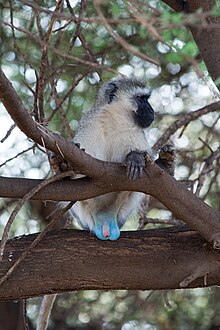
Back Blouaap Afrikaans هجرس أخيضر Arabic Medjol (Chlorocebus pygerythrus) AVK Вервет Bulgarian Verved Breton Chlorocebus pygerythrus Catalan Chlorocebus pygerythrus CEB Südliche Grünmeerkatze German Fio EE Chlorocebus pygerythrus Spanish
| Vervet monkey[1] | |
|---|---|

| |
| Adult male vervet monkey | |
| Calls recorded at Lake Naivasha, Kenya | |
| Scientific classification | |
| Domain: | Eukaryota |
| Kingdom: | Animalia |
| Phylum: | Chordata |
| Class: | Mammalia |
| Order: | Primates |
| Suborder: | Haplorhini |
| Infraorder: | Simiiformes |
| Family: | Cercopithecidae |
| Genus: | Chlorocebus |
| Species: | C. pygerythrus
|
| Binomial name | |
| Chlorocebus pygerythrus F. Cuvier, 1821
| |

| |
| Native range | |
The vervet monkey (Chlorocebus pygerythrus), or simply vervet, is an Old World monkey of the family Cercopithecidae native to Africa.[3] The term "vervet" is also used to refer to all the members of the genus Chlorocebus. The five distinct subspecies can be found mostly throughout Southern Africa, as well as some of the eastern countries. These mostly herbivorous monkeys have black faces and grey body hair color, ranging in body length from about 40 cm (16 in) for females, to about 50 cm (20 in) for males.
In addition to behavioral research on natural populations, vervet monkeys serve as a nonhuman primate model for understanding genetic and social behaviors of humans. They have been noted for having human-like characteristics, such as hypertension, anxiety, and social and dependent alcohol use.[4] Vervets live in social groups ranging from 10 to 70 individuals, with males moving to other groups at the time of sexual maturity. Studies done on vervet monkeys involve their communication and alarm calls, specifically in regard to kin and group recognition, and particular predator sightings.
- ^ Groves, C. P. (2005). "Chlorocebus pygerythrus". In Wilson, D. E.; Reeder, D. M. (eds.). Mammal Species of the World: A Taxonomic and Geographic Reference (3rd ed.). Baltimore: Johns Hopkins University Press. p. 159. ISBN 0-801-88221-4. OCLC 62265494.
- ^ Butynski, T.M.; de Jong, Y.A. (2019). "Chlorocebus pygerythrus". IUCN Red List of Threatened Species. 2019: e.T136271A17957823. doi:10.2305/IUCN.UK.2019-3.RLTS.T136271A17957823.en. Retrieved 19 November 2021.
- ^ "Vervet Monkey (Chlorocebus pygerythrus)". iNaturalist. Retrieved 6 June 2023.
- ^ Palmour, R.; Mulligan, J.; Howbert, J. J.; Ervin, F. (1997). "Of monkeys and men: vervets and the genetics of human-like behaviors". American Journal of Human Genetics. 61 (3): 481–488. doi:10.1086/515526. PMC 1715973. PMID 9326311.
© MMXXIII Rich X Search. We shall prevail. All rights reserved. Rich X Search
